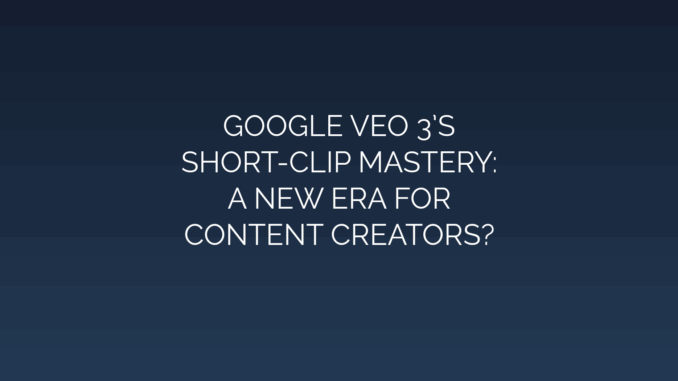
Google Veo 3’s Short-Clip Mastery: A New Era for Content Creators?
The digital content landscape is evolving at breakneck speed, and shortform video has emerged as the undisputed king. Platforms like TikTok, Instagram Reels, and YouTube Shorts dominate user attention, demanding constant innovation from creators. Enter Google Veo 3, the latest evolution of Google’s generative video AI. Boasting unprecedented capabilities in shortclip mastery, Veo 3 promises to redefine how content is conceived, produced, and distributed. But does it truly herald a new era for content creators? Let’s explore its potential and implications.
The Genesis of Google Veo 3 Google Veo 3 builds on its predecessors by leveraging breakthroughs in generative AI and neural rendering. Unlike basic clip generators, Veo 3 analyzes prompts to produce highfidelity, cohesive videos up to a minute long. It interprets context, emotional tone, and visual aesthetics, translating ideas into dynamic scenes with realistic motion, lighting, and sound. This isn’t incremental progress—it’s a quantum leap in AIdriven video synthesis, making sophisticated production accessible to creators of all skill levels.
Unleashing New Creative Possibilities The core innovation of Veo 3 lies in its shortclip mastery. Here’s how it empowers creators:
1. PrompttoVideo Intuition Creators can describe scenes in natural language (e.g., “a neonlit cyberpunk street at night, rainslicked pavement reflecting holographic ads”). Veo 3 generates nuanced clips that match descriptions, reducing reliance on stock footage or manual editing.
2. Style Customization Users apply specific artistic styles—photorealistic, animated, vintage film grain, or abstract—ensuring brand consistency across content.
3. ContextAware Editing The AI adds logic to sequences. For example, a prompt like “a cat chasing a laser pointer up a bookshelf” yields clips with believable physics and object interaction.
4. Dynamic Audio Synergy Veo 3 syncs background scores, ambient sounds, or voiceovers to visual rhythm, heightening emotional impact.
This proficiency allows creators to generate viralready shorts in minutes, bypassing lengthy filming or complex 3D rendering software.
Reshaping the Content Creation Workflow Content creators face relentless pressure to produce high volumes of engaging clips. Veo 3 disrupts traditional workflows:
- Speed & Scalability: Prototype concepts rapidly, test iterations, and scale output for daily social media demands.
- Resource Efficiency: No cameras, sets, or actors required—ideal for budget-conscious creators.
- Experimentation Freedom: Explore ideas too costly or technically challenging for manual production.
For example, a travel vlogger can simulate drone shots of Iceland’s volcanoes without leaving their studio, while an educator animates complex scientific concepts on demand.
Optimizing for ShortForm Platforms Google Veo 3’s design prioritizes platformnative brilliance:
- Vertical & Horizontal Formats: Auto-optimizes aspect ratios for Reels, Shorts, or TikTok.
- Trend Integration: Mimics viral video elements (quick cuts, transition effects, text overlays) to boost engagement.
- Accessibility: Auto-generates captions and adjusts pacing for optimal viewer retention.
This streamlines platformspecific adaptation—a critical edge in algorithmdriven environments.
Industry Applications: Beyond Hobbyists Shortclip mastery extends beyond influencers: 1. Marketing Teams: Craft product demos, ads, and promotional snippets at scale. 2. Independent Filmmakers: Previsualize scenes or create proofofconcept trailers. 3. Journalism: Turn articles into digestible video summaries. 4. UX Designers: Simulate app interactions for client presentations.
Ethical Questions and Limitations Despite its promise, Veo 3 raises challenges:
- Misinformation Risks: Deepfake concerns intensify with photorealistic AI videos. Google counters this via synthetic watermarking and advisories.
- Creative Authenticity: Overreliance could homogenize styles or devalue human artistry.
- Skill Gaps: Mastery still requires prompt engineering—detailed inputs yield superior outputs.
- Resource Constraints: High GPU demands may limit access for casual creators.
Transparent labeling of AIgenerated content and robust moderation guardrails remain essential.
The Future of AIDriven Creation Google Veo 3 signals a paradigm shift. As AI evolves, we’ll likely see:
- Longer and more coherent AI-generated narratives.
- Seamless integration with tools like Photoshop and Premiere Pro.
- Real-time collaborative editing via multimodal inputs (voice, text, image).
For creators, this means shifting focus from production to vision. Storyboarding, ideation, and audience strategy become paramount, while Veo 3 handles execution.
Conclusion: A Transformative Tool, Not a Replacement Google Veo 3 isn’t replacing human creativity—it’s augmenting it. By mastering shortclip generation, content creators gain a tireless collaborator that democratizes highimpact video production. The tool lowers entry barriers for emerging artists while freeing veterans from repetitive tasks, funneling energy into innovation.
As Veo 3 matures, its success will hinge on ethical deployment and adaptive strategies. Creators who leverage it to enhance individuality—not erase it—will thrive. Welcome to the new frontier: where imagination fuels creation, and technology wears a cinematographer’s hat.
Word Count: 996
Leave a Reply